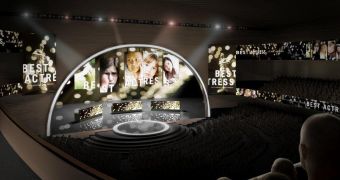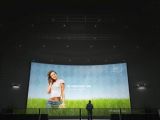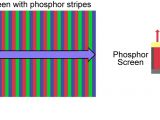Back in the first half of January, just when the 2010 International Consumer Electronics Show was over and companies had finished demonstrating their latest advancements in LCD display technologies, Prysm suddenly stepped up with the announcement that it had created a new type of display. Dubbed laser phosphor display, or LPD for short, this new technology claimed to not only enable high-detail images of any sizes, resolutions and shapes, but also that it achieved this while being not only more power efficient but also cheaper to manufacture than LCDs.
LPD is made up of two main elements, namely a laser engine and a phosphor screen. The Laser Engine is composed of solid state laser diodes (LD) similar to those used in high-density optical storage devices. These diodes emit lasers that boast high precision and can vary in intensity.
When excited by these lasers, the phosphors that make up the screen itself emit red, green and blue colors with a very rapid response. This approach not only enables a high refresh rate but also a high power efficiency as an effect of the phosphors being completely passive unless activated. This passivity excludes the possibility of frozen or burned-in images and also means that the phosphor pixels are not subject to mechanical or electrical failure.
An added benefit of the LPD architecture is the fact that the phosphors themselves are very close to the screen's surface. This gives the technology a high viewing angle, which is important for all display panels but especially for the large-format applications that the LPD primarily targets. Overall, the LPD is 75% more power efficient than other displays.
Following the company's initial announcement, we managed to get it to provide some details and explain some of the LPD's more intriguing features, such as free form, advantages over LCD and the market segments where the technology might be implemented.
Softpedia: The recently introduced Laser Phosphor Display (LPD) was described as superior in several ways to any other large-format display technologies. Besides the high power efficiency and use of non-toxic materials, how exactly is LPD superior to LCD? Can you more closely describe the improvements to resolution, refresh rates, color gamut and image clarity?
Prysm: Among the benefits described above, the benefits over LCD include crisp motion response without blurring since the phosphor pixels respond so fast. Second, the manufacture of LPD is very low footprint and does not require large energy, water and material consuming fabs. Third, LPD can be scaled economically to any size and shape where LCD cannot since the fab cost rises exponentially with size.
Softpedia: Can you give us a few details on the main design and manufacturing elements that enable these advantages?
Prysm: LPD efficiency comes primarily from the fact that the laser engine only turns on as needed on a pixel by pixel basis. Other technologies have a light source that is on at full power and then filtered.
Softpedia: There's an increasing interest in the adoption of LEDs in today's displays. Your approach implies the adoption of solid state laser diodes. Can you explain some of the advantages and disadvantages of using LDs?
Prysm: LDs are very efficient light sources but they also have the advantages of precision. Optics can bring the light precisely to where it is needed in the display unlike other light sources like LEDs where the light is controlled less efficiently.
Softpedia: The IT industry has seen a 3D display rise in popularity over the past year. Can or will LPD support this display mode?
Prysm: Since LPD has full 240Hz refresh rate it supports 3D and multiview functionality with high quality.
Softpedia: What does 'free form' imply exactly? When launched, LPD was said to be capable of taking “any shape, size and resolution.” Does this mean that it can even take spherical, oval or other such shapes besides just that of flat or curved panels?
Prysm: Yes it can. As long as the screen shape can be fabricated and there is clear line of sight for the laser engine to create the image, any shape or size is possible.
Softpedia: Currently, is there some sort of technical or design limitation that makes this technology unusable in displays of smaller formats? If so, could this limitation eventually be overcome?
Prysm: There is no design limitation however many small display markets are being well served by existing technology. Prysm has determined that the value added by LPD is very large in large format applications that are not served well by conventional technology.
Softpedia: Besides public implementations, do you see the possibility of LPD coming to homes worldwide, replacing the current LCD technology? If so, can you estimate a time frame for that?
Prysm: We expect LPD to have applicability in residences and to be a valuable alternative to other technologies but we cannot estimate a schedule for that.
Softpedia: At this time, what is the level of interest that you see for LPD and how do you expect the industry to react to your product?
Prysm: After our company launch and technology demo at ISE we have seen phenomenal interest from the commercial display industry. Many opportunities exist to save energy and improve the display experience worldwide.
Softpedia: The product's announcement said that Prysm had spent the past four years preparing the new display technology. Was the Laser Phosphor Display the only focus or has Prysm been working on other projects, perhaps to complement or enhance LPD?
Prysm: Prysm is a manufacturer of display systems and the company has focused on that.
Softpedia: Does Prysm have any plans for a demonstration in the near future? When and where will the industry be able to see LPD in action?
Prysm: Prysm will be exhibiting a showcase of LPD at InfoComm in Las Vegas, June 9-12, 2010.

 14 DAY TRIAL //
14 DAY TRIAL // 


